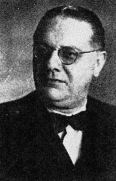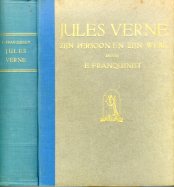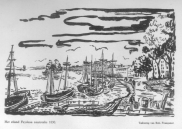E.M.C.B. Franquinet LL.M.
Discourse by Cees Moonen at the meeting of the Dutch Jules Verne Society on 28 March 1998.
Youth and family

(Click to enlarge.)
I am going to tell you about E. M. C. B. Franquinet LL.M., the writer of
the only Dutch biography on Jules Verne so far. Edmond Marie Constant
Bernard Franquinet (Eddy) was born in Maastricht on 6 January 1896, as the
sixth and last child in the family. He died on 17 November 1974, almost 79
years old. His father was a well-known Maastricht industrialist. Many of
his ancestors had been mayor of Namen (Belgium) in the 17th century. Also,
writing was in the blood of these ancestors. There was a physicist who
published a lot in the last century. Franquinet’s grandfather was a member
of the Society of Dutch Literature, had a degree in Law, was a historian,
civil servant and consul for Belgium and Spain.
Back to our Edmond. When he was 9 years old, he moved with his family to
Houthem, near Valkenburg. Only French was spoken in the Franquinet family.
In Houthem, Edmond had a private teacher at home. Later, he went to
grammar school, and after school he left for Amsterdam to study Law.
Because he did all kinds of things except studying, he had to begin all
over again three years later, this time in Utrecht. When he was 27 years
old, he got his degree in Law. A year before, in 1922, he got married. No
offspring resulted from this marriage. After several jobs in the
judicature in Maastricht, Gulpen en Utrecht, Franquinet was appointed
judge at the court of justice in Roermond, of which he was vice-president
from 1947 until his retirement in 1966.
Eddy was a somewhat thick-set figure, with a gentle and amiable character,
a very social man who loved weddings and parties, but, strangely enough,
didn’t like carnival at all. He frequently organized parties and diners,
of which often more than thirty persons partook.
Aviation, writing and other interest
Now I am going to talk about a completely different side of Edmond
Franquinet. From his youth up, writing ran in his blood. At 17 years, he
had already written an article entitled Nr. 47, a story about an aerial
race, for which he was paid ƒ 2,50 by a local newspaper, the Brabantse
Courant in Den Bosch. His greatest hobby has always been aviation, en this
preference has only increased in the years.
Besides aviation, a lot of other topics had his interest: literature, art,
biographies of persons who were important for the culture of Limburg, old
farms and buildings, nature and so on. From the middle twenties Franquinet
published a book on one of these topics almost every year. However,
aviation and space travel remained his first and biggest love.
Franquinet was one of the founders of the committee ‘Vliegveld
Zuid-Limburg’, the current ‘Airport Aachen-Maastricht’. From 1932 he
edited a monthly feature on KRO radio: KRO Luchtnet. After the war he
resumed this program, under the title De vliegende Hollander on Sunday
afternoon. He continued until 1964. It was the longest-existing radio show
ever: 27 years! Another radio show worth mentioning is Sprong in het
heelal. This radio play was broadcast between 1955 and 1958 on Sunday
night at half past nine. It was a series with stories like a trip to the
moon and later to Mars, by the novelist Charles Chilton, translated by our
Edmond.
These activities were all under the pseudonym P. R. O. Peller, on the
explicit request of the Minister of Justice, in order to keep a distance
between his work as a judge in Roermond and his writing. Anything new
about mixed interests?
In 1929 Edmond Franquinet went for his first flight, together with his
wife: in a new one-engine KLM Fokker plane he flew from Brussel to Paris.
In 1930 he made his first flight in a private plane that he flew himself.
In the same year his first book on aviation was published. In 1936, Edmond
became a teacher at the Dutch Institute of Aviation in Utrecht; here he
wrote the first Dutch Aviation Encyclopedia, in cooperation with
others.
Besides writing over 800 articles in approximately 40 different magazines
about aviation, space travel, language and culture of Zuid-Limburg, etc.
etc., he also liked painting, drawing and photography. In the 1930s, 1950s and
1960s, he made many travels with his wife, and he wrote complete books about
these trips, illustrated with his own photos and drawings. He also gave
lectures throughout the country, showing lantern-views and later colour
slides.
Franquinet wrote no less than 21 books on his favourite topics. He also
translated 12 works from French, German and English, most of them about
science-fiction and space travel.

(Click to enlarge.)
Jules Verne
You will be thinking by now: “That’s all very nice, but what about Jules
Verne?” All in due time, gentlemen! First I want to point out certain
peculiarities of both writers. They were both real voluminous writers, and
liked to be at work as early as five o’clock in the morning. And both of
them were very normal and inconspicuous persons, who had quiet, bourgeois
lives.
And now, finally, about Jules Verne. In the war period 1940–1945 there was
not much work to do at the court of justice in Roermond. So Franquinet
decided to write a biography on one of the heroes of his youth: Jules
Verne. In 1940–1941 he finished this work. And although it may seem to us
a little old-fashioned, it is still a book worth reading. The pen-drawings
in the book were made by his cousin Robert Franquinet, who had written a
lot himself.


(Click to enlarge.)
When Edmond started work on his biography on Verne, he had only read 40
novels by Verne. He could not find the other works, not even in libraries.
He then contacted Cornelis Helling in
Amsterdam, the man who helped founding the French Société Jules Verne in
1935, and has been vice-president of this Société for about thirty
years.
Helling was willing to let Franquinet read his books, but on one
condition: Helling wanted to come to Roermond every weekend. And so it
happened. Every Saturday Cornelis Helling came to Franquinet’s house with
six French first editions, and on Sunday night he left again. This went on
for a couple of months: Edmond sitting upstairs, reading, making
abstracts, while Helling was downstairs eating and drinking. Mark you, it
was war!
The biography Jules Verne, zijn persoon en zijn werk appeared in 1942,
published by De Pelgrim in Eindhoven.
Other publications by Edmond Franquinet about Jules Verne are:
- 1945: Een dagblad in de 29e eeuw, a translation of La Journée d’un journaliste américain en 2889, with an extensive preface.
- 1964: a renewed edition of his biography on Verne.
- 1969: Een zee voor de Sahara, a translation of L’Invasion de la Mer.
- 1972: Een dokters-visite, a translation of Frritt-Flacc, in the magazine Holland-SF.
- In 1973 Franquinet was working on a translation of L’Eternel Adam; the translation, De eeuwige Adam, was published in 1974 by R van Hevel, Ilsestraat, Oevel, Belgium.


(Click to enlarge.)
Gentlemen, I hope that I have been able to lift the curtain about a person who has been very important to us all, and who will be important as long as there will be one fan of Jules Verne left in the Netherlands!